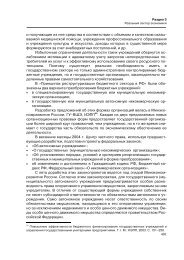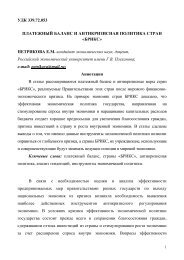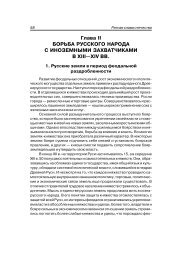Chapter 8: A Set of Measures for <strong>Ensur<strong>in</strong>g</strong> <strong>Strategic</strong> <strong>Stability</strong> as an Exampleof an “Asymmetric Response” to Ronald Reagan’s <strong>Strategic</strong> Defense InitiativeProblems of secur<strong>in</strong>g strategic stability were vigorously discussed by <strong>the</strong> Soviet Union <strong>and</strong> <strong>the</strong>United States <strong>in</strong> <strong>the</strong> 1980s, which to a large extent was <strong>in</strong>duced by <strong>the</strong> emergence of <strong>the</strong> wellknown<strong>Strategic</strong> Defense Initiative (SDI) of U.S. President Ronald Reagan <strong>and</strong> <strong>the</strong> problem ofmedium-range missiles <strong>in</strong> Europe. At that time, Soviet scientists <strong>and</strong> experts (primarily as partof <strong>the</strong> activities of <strong>the</strong> Velikhov group) formulated <strong>the</strong> concept for a doctr<strong>in</strong>al directive regard<strong>in</strong>gspecific programs to be deployed as an asymmetric response to <strong>the</strong> SDI program. The developedconcept was eventually adopted by <strong>the</strong> leadership of <strong>the</strong> USSR.This experience is still significant from both <strong>the</strong> <strong>the</strong>oretical <strong>and</strong> <strong>the</strong> purely applied viewpo<strong>in</strong>ts.The pr<strong>in</strong>cipal difference of <strong>the</strong> SDI concept from previous attempts to develop a multi-level missiledefense system primarily lies <strong>in</strong> <strong>the</strong> fact that <strong>the</strong> particular R&D programs considered by <strong>the</strong>Pentagon were focused (a) on <strong>the</strong> space echelon of <strong>the</strong> missile defense system, <strong>and</strong> (b) on suchexotic means of destruction as various types of lasers, electromagnetic mass drivers, <strong>and</strong> particleaccelerators.The possibility of us<strong>in</strong>g high-power laser radiation to hit various targets was placed on <strong>the</strong> agenda<strong>in</strong> <strong>the</strong> mid-1960s. At that time <strong>the</strong> Soviet Union, <strong>the</strong> United States <strong>and</strong> a number of o<strong>the</strong>r countries(especially France) had research programs aimed at development of laser weapons. It wasanticipated that such peculiar feature of lasers as <strong>the</strong> ability to concentrate <strong>the</strong> beam energy on asmall area on <strong>the</strong> surface of a target could lead to damage or destruction of a non-armored target(first of all, aircraft or missile bodies). 63A non-expert would f<strong>in</strong>d <strong>the</strong> SDI concept quite impressive. Reagan had set up a gr<strong>and</strong> task: torid <strong>the</strong> United States of <strong>the</strong> fear of nuclear weapons by render<strong>in</strong>g <strong>the</strong>m “outmoded <strong>and</strong> unnecessary”—i.e., to develop a perfect shield aga<strong>in</strong>st what was called <strong>the</strong> “Soviet nuclear threat.”The reaction of <strong>the</strong> major part of <strong>the</strong> Soviet leadership to <strong>the</strong> <strong>Strategic</strong> Defense Initiative putforward by President Reagan was more than negative (<strong>and</strong> it quite deserved such an attitude). 64SDI ru<strong>in</strong>ed <strong>the</strong> view of secur<strong>in</strong>g strategic stability that had just been formed <strong>in</strong> <strong>the</strong> m<strong>in</strong>ds of <strong>the</strong>elderly leaders of <strong>the</strong> country who poorly digested new <strong>in</strong>formation <strong>and</strong> new developments. Thelevel of technical competence at <strong>the</strong> top of <strong>the</strong> state apparatus (except for <strong>the</strong> Military IndustrialCommission of <strong>the</strong> Council of M<strong>in</strong>isters of <strong>the</strong> USSR, part of <strong>the</strong> State Plann<strong>in</strong>g Committee <strong>and</strong><strong>the</strong> Defense Industry Department of <strong>the</strong> Central Committee of <strong>the</strong> CPSU, technocrats <strong>in</strong> <strong>the</strong>adm<strong>in</strong>istration of <strong>the</strong> relevant m<strong>in</strong>istries of <strong>the</strong> defense <strong>in</strong>dustry, <strong>and</strong> <strong>the</strong> Office of <strong>the</strong> Chief of <strong>the</strong>Armaments Department of <strong>the</strong> M<strong>in</strong>istry of Defense of <strong>the</strong> USSR) was quite low.It should also be kept <strong>in</strong> m<strong>in</strong>d that <strong>in</strong> <strong>the</strong> 1980s, a number of high-rank<strong>in</strong>g officials <strong>in</strong> <strong>the</strong> ReaganAdm<strong>in</strong>istration remarked that a nuclear war could be won or lost, <strong>and</strong> <strong>the</strong> Soviet leadership perceivedsuch statements very seriously. 6536<strong>Ensur<strong>in</strong>g</strong> <strong>Strategic</strong> <strong>Stability</strong> <strong>in</strong> <strong>the</strong> <strong>Past</strong> <strong>and</strong> <strong>Present</strong>: Theoretical <strong>and</strong> Applied Questions
In <strong>the</strong> beg<strong>in</strong>n<strong>in</strong>g of <strong>the</strong> 1980s, <strong>the</strong>re were many media leaks <strong>in</strong> <strong>the</strong> U.S. concern<strong>in</strong>g various possibilitiesof U.S.-launched decapitation strikes aga<strong>in</strong>st <strong>the</strong> Soviet Union (for several decades <strong>the</strong>U.S. had been discuss<strong>in</strong>g a wide range of ways of wag<strong>in</strong>g <strong>and</strong> w<strong>in</strong>n<strong>in</strong>g a nuclear war). 66 The USSR<strong>in</strong>tensified its activities aimed at <strong>the</strong> development of systems <strong>and</strong> means of strategic <strong>and</strong> tacticalwarn<strong>in</strong>g of <strong>the</strong> adversary’s preparations for a massive preemptive strike—both <strong>in</strong> <strong>the</strong> militarydepartments <strong>and</strong> <strong>in</strong> <strong>the</strong> KGB, which was headed by Yuri Andropov. A number of pr<strong>in</strong>cipal strategicwarn<strong>in</strong>g ideas (based on record<strong>in</strong>gs of a set of signs of <strong>the</strong> pr<strong>in</strong>cipal potential adversary’spreparations for a nuclear missile assault) were formulated <strong>in</strong> <strong>the</strong> 1970s at <strong>the</strong> Institute of <strong>the</strong> U.S.<strong>and</strong> Canada Studies of <strong>the</strong> Academy of Sciences of <strong>the</strong> USSR (here it is necessary to emphasize <strong>the</strong>role of <strong>the</strong> alumnus of <strong>the</strong> Department of Physics of Moscow State University, Doctor of HistoricalSciences Andrei Zhukov, who later headed a special department of <strong>the</strong> First Ma<strong>in</strong> Directorateof <strong>the</strong> KGB of <strong>the</strong> USSR). In comb<strong>in</strong>ation with <strong>the</strong> aforementioned focus of <strong>the</strong> 1980 platform of<strong>the</strong> U.S. Republican Party on <strong>the</strong> atta<strong>in</strong>ment of “overall military superiority” by <strong>the</strong> United Statesover <strong>the</strong> Soviet Union, all that looked quite om<strong>in</strong>ous. As <strong>in</strong> previous years, many state <strong>and</strong> partyleaders <strong>and</strong> military comm<strong>and</strong>ers were <strong>in</strong>st<strong>in</strong>ctively <strong>in</strong>cl<strong>in</strong>ed to react with a “spike-aga<strong>in</strong>st-spike”response <strong>and</strong> a strategy of symmetric measures (although by that time, more <strong>and</strong> more peopleunderstood that ano<strong>the</strong>r round of <strong>the</strong> arms race, with <strong>the</strong> development <strong>and</strong> manufactur<strong>in</strong>g ofextremely expensive systems based on new physical pr<strong>in</strong>ciples, would be unaffordable for <strong>the</strong>USSR).Sen. Malcolm Wallop encouraged <strong>the</strong> United States to implement a space-based BMD programsimilar to <strong>the</strong> Manhattan project, which resulted <strong>in</strong> creation of <strong>the</strong> atomic bomb, <strong>and</strong> to strivefor <strong>the</strong> elim<strong>in</strong>ation of <strong>the</strong> “balance of fear” that was typical of <strong>the</strong> scenario of mutually assureddestruction that had emerged <strong>in</strong> U.S.-Soviet relations <strong>in</strong> <strong>the</strong> strategic nuclear area <strong>in</strong> <strong>the</strong> previousdecades. 67Attempts to br<strong>in</strong>g SDI <strong>in</strong>to l<strong>in</strong>e with such large-scale complex technical projects as, for example,<strong>the</strong> Manhattan project that created <strong>the</strong> atomic bomb, or <strong>the</strong> Apollo space program that l<strong>and</strong>ed<strong>the</strong> first human on <strong>the</strong> moon, were confus<strong>in</strong>g. The pr<strong>in</strong>ciple difference of <strong>the</strong> SDI program is thatit contests not just <strong>the</strong> laws of nature, which can be understood <strong>and</strong> rema<strong>in</strong> unchanged, but alsoa prudent adversary, who can unpredictably use <strong>the</strong> same laws aga<strong>in</strong>st <strong>the</strong> creators of <strong>the</strong> defensesystems, <strong>and</strong> who forces <strong>the</strong>m to provide for all possible types of countermeasures. 68Intuitively, many average Americans had l<strong>in</strong>ger<strong>in</strong>g hopes that <strong>in</strong> <strong>the</strong> course of implementationof <strong>the</strong> SDI program <strong>the</strong>re would be a technical miracle that would immediately do away with all<strong>the</strong> difficulties predicted by numerous critics of <strong>the</strong> SDI program. This was a sh<strong>in</strong><strong>in</strong>g example ofwishful th<strong>in</strong>k<strong>in</strong>g.Reagan was a well-known Hollywood actor, trade union official <strong>and</strong> successful governor of California.He unshakably believed <strong>in</strong> <strong>the</strong> omnipotence of <strong>the</strong> American genius, although he himselfwas an absolute know-noth<strong>in</strong>g regard<strong>in</strong>g technology <strong>and</strong> <strong>the</strong> natural sciences. In his underst<strong>and</strong><strong>in</strong>gof <strong>the</strong> problems of military-strategic balance <strong>and</strong> strategic stability, Reagan was far beh<strong>in</strong>d notjust his predecessors, <strong>in</strong>clud<strong>in</strong>g Republican President Nixon <strong>and</strong> Democratic President JimmyCarter, but also beh<strong>in</strong>d Republican President Gerald Ford, whose narrow-m<strong>in</strong>dedness was <strong>the</strong>subject of many jokes <strong>in</strong> <strong>the</strong> American political establishment (as a matter of fact, Ford was notthat narrow-m<strong>in</strong>ded).Belfer Center for Science <strong>and</strong> International Affairs | Harvard Kennedy School 37
















